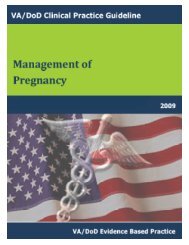DM Full Guideline (2010) - VA/DoD Clinical Practice Guidelines Home
DM Full Guideline (2010) - VA/DoD Clinical Practice Guidelines Home
DM Full Guideline (2010) - VA/DoD Clinical Practice Guidelines Home
Create successful ePaper yourself
Turn your PDF publications into a flip-book with our unique Google optimized e-Paper software.
Version 4.0<br />
<strong>VA</strong>/<strong>DoD</strong> <strong>Clinical</strong> <strong>Practice</strong> <strong>Guideline</strong><br />
for the Management of Diabetes Mellitus<br />
Puncture wound - A lesion through the epidermis, dermis, and other tissues caused by a piercing or penetrating<br />
object. Patients with diabetes with puncture wounds can quickly develop severe limb-threatening complications.<br />
Ingrown Toenail<br />
Ingrown toenail - Presents as a nail plate that has pierced the surrounding periungual tissue with associated erythema<br />
and drainage or an area of thick or discolored callus. The primary care provider should consider referral to a<br />
podiatrist for excision of infected ingrown nails, especially in the case of high-risk patients (Giacalone, 1997).<br />
Hemorrhagic Callus With or Without Cellulitis<br />
The provider must determine if the cellulitis may be associated with callus tissue or necrotic tissue that may obscure<br />
an underlying ulceration or deeper infection.<br />
The callus tissue must be debrided to properly assess the extent of an underlying ulceration and possible deeper<br />
more serious infection. Necrotic tissue must also be debrided to help eradicate the infection and determine the full<br />
extent of the infection. The patient should be promptly referred to a foot care specialist for complete evaluation and<br />
treatment.<br />
evidence<br />
Recommendation Sources LE QE SR<br />
1 Assessment of peripheral vascular<br />
disease.<br />
2 Evaluation for acute ischemia or<br />
rest pain.<br />
Carrington et al., 2001<br />
II-1 Fair B<br />
Orchard , 1993<br />
III<br />
Orchard , 1993 III Poor I<br />
3 Evaluation for foot ulceration. ADA, 2002<br />
III Poor I<br />
Brodsky , 1991<br />
Caputo et al., 1994<br />
Eckman et al., 1995<br />
Reiber et al., 1995<br />
4 Evaluation for ingrown toenail. Giacalone, 1997 II-1 Fair B<br />
LE-Level of Evidence; QE = Quality of Evidence; SR = Strength of Recommendation (see Appendix A).<br />
D. Refer to Appropriate Level of Care for Evaluation and Treatment<br />
OBJECTIVE<br />
Determine the appropriate intervention.<br />
RECOMMENDATIONS<br />
1. Patients with limb-threatening conditions should be referred to the appropriate level of care for evaluation<br />
and treatment.<br />
2. If the patient’s symptoms limit his/her lifestyle, a vascular specialist should determine the appropriateness<br />
of surgical intervention on a patient-specific basis. Justification of vascular procedures should be based on<br />
the outcomes of the vascular interventions.<br />
Discussion<br />
The patient with cellulitis, that is not complicated by hemorrhagic callus or necrotic tissue, and without systemic<br />
signs of infection, should be treated with appropriate antibiotics, off-loading weight from the affected limb, and<br />
aggressive follow-up to ensure that the condition does not become severe.<br />
The patient should be alert to signs and symptoms of systemic infection to include fever, chills, nausea and<br />
vomiting, and elevation in blood sugars. If the patient manifests any of these symptoms, he/she should notify the<br />
provider immediately. If the infection has not resolved within 7 days of oral therapy or there is a worsening of the<br />
symptoms, the patient should be admitted to a hospital for appropriate IV antibiotic therapy. Once the cellulitis has<br />
Module F – Foot Care Page 99
















